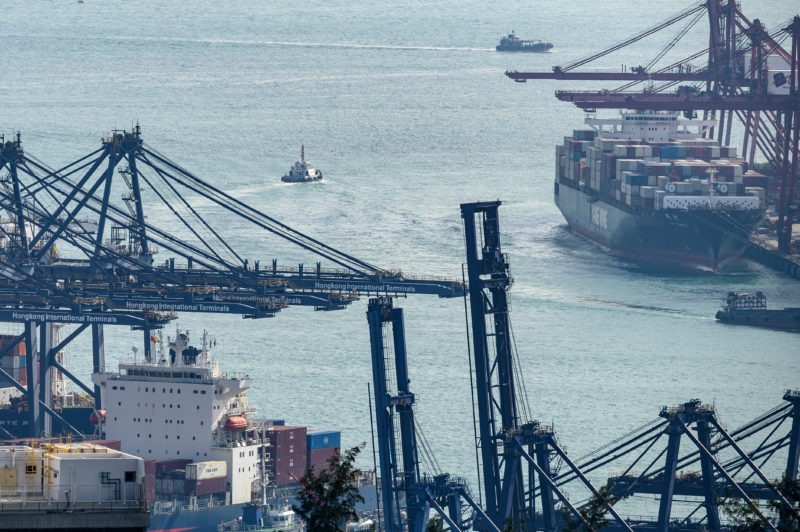Slow boat to China: cargo ships urged to cut speed and pollution
New norms will force ships to lower the sulphur content in their fuel in a bit to slash emissions at least 40 percent from 2008 levels by 2030 (Philip FONG)
Paris (AFP) – Moving cargo ships into the slow lane, an idea French President Emmanuel Macron floated at the G7 summit in Biarritz, would be one way to cut maritime transport’s giant carbon emissions footprint.
Here, AFP looks at how the debate took shape and is evolving:
– Ecological impact –
Shipping represents 2.3 percent of carbon dioxide (C02) emissions, according to French transport trade body Armateurs de France and the International Maritime Organization (IMO) — a bigger share than the 2.0 percent generated by the aviation industry as estimated by the International Aviation Organisation (OACI).
Much of the impetus for slow steaming is the fact that the more than 90,000 large scale commercial vessels such as container ships, oil tankers and bulk freighters which ply their trade across the world’s oceans are primarily powered by heavy, high sulphur and high nitrogen-content fuel which contributes to airborne particulate matter.
The contribution of maritime transport contribution to global CO2 emissions “should hit 17 percent by 2050 if nothing is done,” says France’s Higher Institute of Maritime Economics (ISEMAR) as maritime freight volumes are expected to quadruple by then.
– Commitments already taken –
The IMO has already decided to limit the level of sulphur compounds in marine fuels to 0.5 percent from a current upper limit of 3.5 percent from next year outside defined sensitive zones already subject to a 0.1 percent cap.
In April last year the IMO adopted a strategy to reduce CO2 emissions by at least 40 percent by 2030 from their 2008 level and 50 percent by 2050 in a sector where experts estimate one large container ship emits as much sulphur gases as millions of cars.
But “the negotiations are foundering on the adoption of short term measures” to make the strategy a reality, the French government admitted following a May meeting with the IMO.
– Improve fuel or drop fossil energies –
In order to respect the new mandated norms from next year, shipping firms will have to switch to marine fuel with lower sulphur content.
Future compliance will also require the firms to equip their vessels with exhaust gas cleaning systems — dubbed “scrubbers” — or find alternative means of propulsion. The liquefied natural gas (LNG) notably being adopted by the future vessels of several French shipping firms look to be the preferred solution today but will require infrastructure upgrades as well as specific on-board storage capacity plus a suitable motor.
Other solutions to explore do not on the surface appear well-suited to long-haul shipping — such as biofuels, hydrogen or electric-powered vessels or even the re-invention of sailing boats.
– Slow down –
Macron considers letting off less steam by slowing down to be “one of the most efficient ways of reducing emissions” and France suggested going down that route to the IMO in April.
By way of example, an oil tanker which drops its speed from 12 to 11 knots can cut its fuel consumption by 18 percent — or by 30 percent if speed is cut to 10 knots, according to the French ministry for ecological transition.
Trimming speed also cuts sound pollution and well as the risk of collisions with whales.
– Protect some zones –
French container and shipping group CMA CGM, touting its goal to act as “a model for sustainable global prosperity,” last week committed itself not to ply the Northern Sea Route through the Arctic off the coast of northern Siberia, a route which global warming, in melting sea ice, is today rendering navigable.
Until now, expensive icebreakers have been a prerequisite to navigate the route, which can lop up to a fortnight off cargo journeys to Europe from Asia.
Given the group ranks third globally as a maritime container transport provider, it is taking a risk given the time but also the amount of fuel savings to be made from taking a shorter route than through the Suez Canal or via the Cape of Good Hope.
France is pushing for greater regulation of pollutant emissions in the Mediterranean by 2022, along the lines of existing rules for the Channel and the North Sea as well as the Baltic Sea.
– Target ports too –
Ports will also have to be targeted as ships continue to burn fuel even when they are at rest, adding to the pollution output. One potential solution is to plug them into the ports’ electric supply but that is not always logistically possible while the ships themselves have not been designed for plug in connections.
French group Stef’s La Meridionale and Corsica Lines are nonetheless experimenting with the idea in Marseille.
Disclaimer: Validity of the above story is for 7 Days from original date of publishing. Source: AFP.


